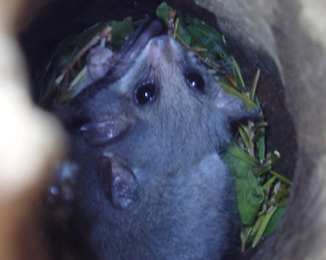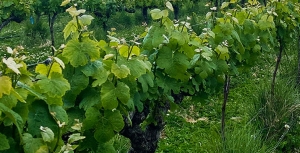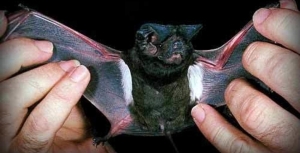Displaying items by tag: microbats
Microbats and vineyards
We don’t tend to associate bats with winemaking except to consider that flying foxes or fruit bats might happily eat grapes. But microbats wouldn't – they're insectivores – so I was fascinated by an article in AgJournal, a supplement published in The Weekend Australian and taken from The Weekly Times. This featured a vineyard in the Strathbogie Ranges in Victoria which is one of several involved in a research project with University of New England (UNE).
The vineyard, a significant producer of 2,500 t of grapes per year, is Fowles Wines and the business mantra of proprietor Matt Fowles is ‘to farm in nature's image’. The partnership with UNE was triggered by his observations that the vines and fruit in locations with microbat populations were thriving and healthier than those elsewhere on the property.
The UNE research is led by Dr Xenon Czenze and Dr Heidi Kolkert whose research had already established that bats play a vital role in pest control in New England vineyards. Fowles Wine has more than a dozen acoustic detectors arranged around the vineyard, a significant bat-monitoring system, and also has a partnership with Euroa Arboretum, with insectariums established to catch and monitor insect comings and goings. Not all insects are bad, and information on the good ones is also essential! All this is capped by attention to and encouragement of the native flora, from bordering bushlands and forests to grasses growing beneath the vines to cool the soil and roots.
Microbats alive and well in South Turramurra
We have been part of Ku-ring-gai Council’s microbat surveys for some time as part of the Pool to Pond program.
Our recent report noted that the water quality in our pond in Kingsford Avenue was excellent and that five species of microbats have been visiting our pond, one of the highest numbers recorded in Ku-ring-gai.
These include the three most common bats:
- Gould’s Wattled Bat (Chalinolobus gouldii) found at 41 sites
- Little Bent-winged Bat (Miniopterus australis) found at 33 sites and vulnerable
- Ride’s Free-tailed Bat (Ozimops ridei) found at 32 sites
as well as the more elusive Little Forest Bat (Vespadelus vulturnus) and the White-striped Freetail Bat (Austronomus australis) pictured above.
Seven species of microbats have been found across Ku-ring-gai. We are sure other STEP members will have contributed to the survey and the biodiversity of our area.
All this is very re-assuring in that Kingsford Avenue was where STEP began in 1978 and is still on the job!
Margaret and John Booth, have provided this good news story.
Biodiversity in Ku-ring-gai
Over 700 native plant species and 300 vertebrate species have been recorded in Ku-ring-gai. On 19 June Chelsea Hankin (council’s Natural Areas Officer) gave an overview of council’s fauna monitoring program, including the latest results of their three long-term monitoring programs. She made the following points.
 Grey-headed Flying-fox
Grey-headed Flying-fox
The Ku-ring-gai Flying-fox Reserve (KFFR) in Gordon has been home to flying-foxes since the 1960s with reports of occupation in the 1940s.
Every third Thursday in the month (in collaboration with Ku-ring-gai Bat Conservation Society and regular volunteers) council conduct fly-out counts at strategic locations surrounding the KFFR.
Monthly counts provide long term data and ties in with the national census.
Numbers flying-foxes have fluctuated, though a downward trend is clear.
KFFR is important during extreme heat when temperatures climb to over 40°C because it has good structural complexity of vegetation layers (canopy, mid- and understorey) so flying-foxes are able to move down into the lower cooler layers of vegetation.
 Eastern Pygmy Possum
Eastern Pygmy Possum
The Eastern Pygmy Possum monitoring program has been running for more than three years in collaboration with volunteers.
28 nest boxes have been installed.
Eastern Pygmy Possums have not been identified on the western Lane Cove NP side of the LGA. We’ve had continued presence of EPP in areas with connectivity to either Ku-ring-gai Chase NP or Garigal NP, with evidence of successful breeding.
Eastern Pygmy-possum have been observed foraging on a range of flora species, including Banksia ericifolia, B. spinulosa, B. serrata, Lambertia formosa, Angophora hispida and Callistemon citrinus.
Cameras have detected plenty of other wildlife: Swamp Wallabies, Feathertail Glider, Brushtail Possum, Antechinus and Sugar Glider.
Microbats
Council began monitoring microbats at Pool to Pond (WildThings program) sites and creek lines in 2017. In 2018 the program was expanded to include natural bushland areas, wetlands, golf course dams and backyards without water features (a total of 64 sites).
Thirteen species have been detected, half of which are threatened.
The three most common species have been Eastern Freetail Bat, Eastern Bentwing-bat (threatened) and Gould’s Wattled Bat (a generalist species and highly adaptable to the urban landscape – sometimes seen taking advantage of insect concentrations around lights).
The specialist fishing bat Southern Myotis (threatened) has only been detected at larger bodies of water like dams, creeks and sediment ponds/wetlands. Southern Myotis require open stretches of water without clutter (aquatic vegetation or algae on surface) so they can ‘trawl’ using their large feet to catch small fish and aquatic invertebrates.
Three new records have confirmed the presence of Chalinolobus dwyeri, a species which until now had only been recorded once in 1992.
Freshwater Crayfish
Targeted surveys of freshwater crayfish in the last year have shown that two native species are co-existing, Euastacus australasiensis and E. spinifex.
Report Sightings
Contribute to council’s biodiversity database by report interesting fauna sightings to This email address is being protected from spambots. You need JavaScript enabled to view it..
Useful Apps
FrogID https://www.frogid.net.au
OzAtlas https://www.ala.org.au/who-we-are/downloadable-tools/ala-mobile-app/ contribute directly to the Atlas of Living Australia database



